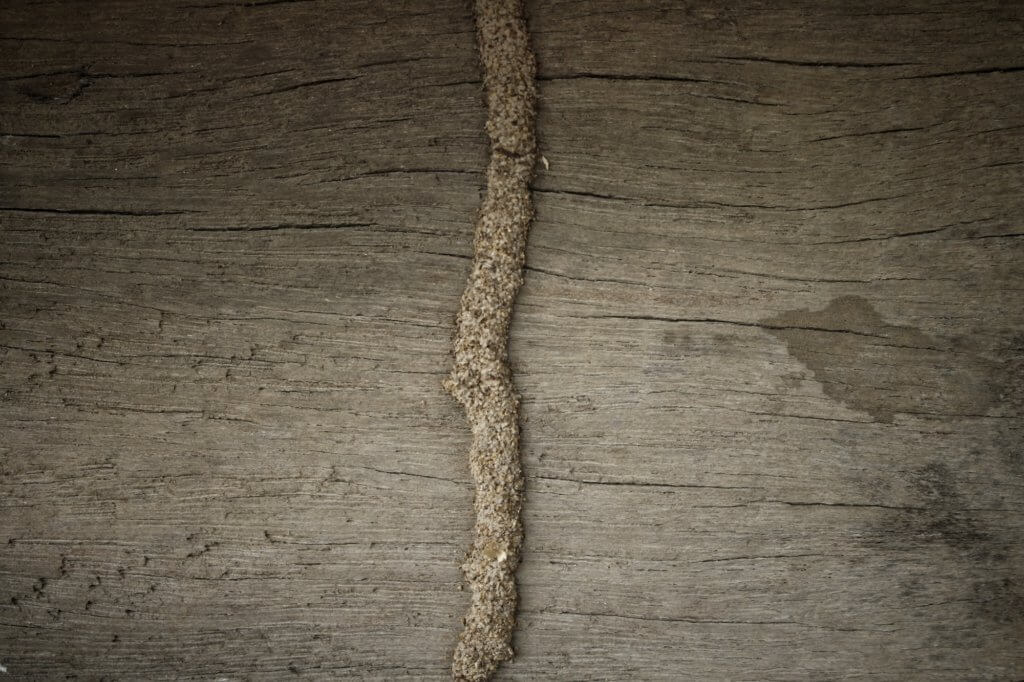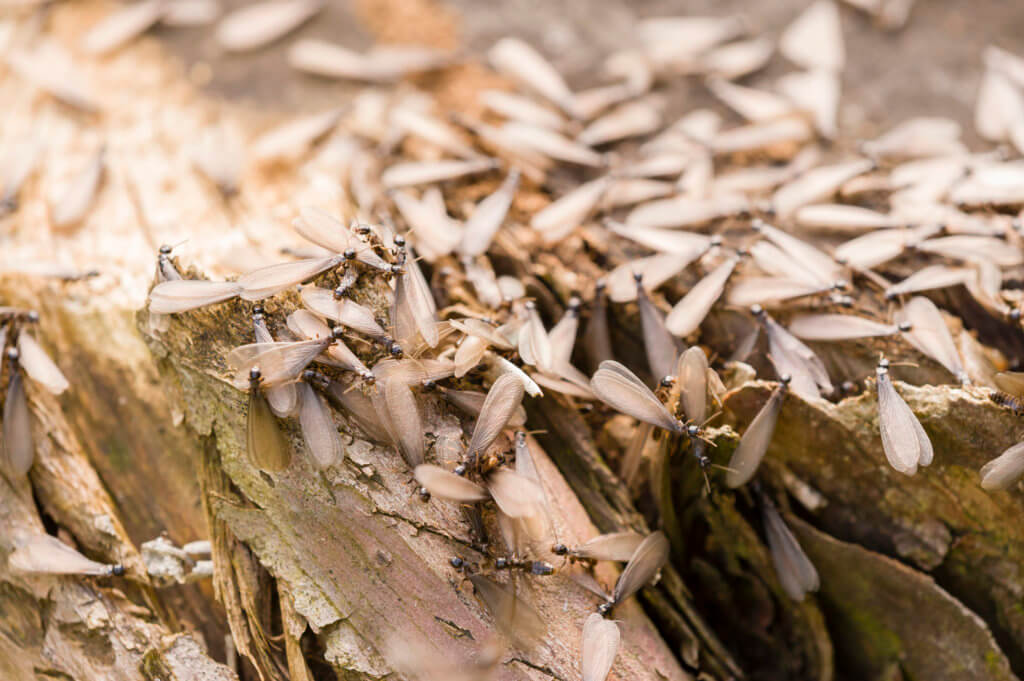As the winter snow starts to melt away and spring begins here in Kansas City, you’re probably facing a laundry list of tasks to get ready for the season. But, while you’re re-planting your garden, getting your lawn ready, and cleaning out the garage for the 12th time, there are more dangerous elements at work getting ready for the season too. Spring is the peak season for termites in Missouri. More specifically, it’s the time when Eastern Subterranean Termites, one of the most destructive species, and the one found predominantly in the state, begin to seek out new structures to feast on. Here are some facts to arm yourself with as you look down the barrel of termite swarm season.
Check Out Our Kansas City Real Estate Termite Inspections
How to Identify Subterranean Termites
Termites function as part of a larger colony, a group of up to 2,000,000 insects that all fulfill different roles in an infestation. Although soldier, worker, reproductive, and queen subterranean termites all contain slight variations in their appearance, they all measure around 1/8th inch in length and have distinct and sharp jaws that allow them to eat through various hard materials. They also appear white, with browner patches near various body parts depending on their role. The workers will be what you see most often, or you may see groups of reproductives, the variety that grows wings and swarms to found a new colony.
Signs of a Subterranean Termite Infestation
The most common sign that you are experiencing an infestation of subterranean termites is the presence of “mud tubes.” As pictured below, these tubes run along the surfaces of various structures and building foundations. Termites build them to protect themselves from the elements. This allows them to gradually reach food sources in otherwise inaccessible locations.

Other warning signs may become visible in your home as an infestation begins to take place. Check for areas of warped wood or pieces of wood that seem hollow when touched. Bubbling paint or darkening of wood structures have also been known to occur. Termites will even leave waste behind. Keep an eye out for small piles of what looks like sawdust in areas where termites could be. Finally, check around your windows for discarded wings. When termites swarm they can attempt to enter your open windows, shed their wings, and begin eating away at wood inside the home itself.
We Offer Commercial Termite Services For Office Buildings
Termite Swarming
Swarming occurs in the spring, when termite colonies’ reproductive members, the young queens, and kings, embark to found a new colony. These insects will sprout wings and pairs of them will swarm away, searching for an adequate food source. This means that colonies that may have developed yards away from your home can leap establishing themselves in your structure. It’s imperative to stay vigilant for signs of swarmers because once the new queen grows into the area, she can begin laying around 1,000 eggs a day. (Pic of wings by a window or a group of reproductives)

Dangers Of Subterranean Termites
Eastern subterranean termites are specifically singled out for their destructive capabilities. While other species may have preferences for damp or dry wood, or a different entry method, these termites one goal in life is to consume as much cellulose as possible. They are quite good at it too. A small colony can easily eat through most of a 2×4 in about a year. That is also compounded by how the colony grows while it’s feasting on your home.
Furthermore, subterranean termites prefer to eat wood for its cellulose content, but they are perfectly capable and willing to carve their tunnels through your home’s foundation to reach it. This damage can represent an unspeakably high cost to the homeowner. According to the National Pest Management Association, termites alone cause US homeowners around $6 billion of damage a year. Unless your insurance covers the damage, (which it usually doesn’t), you’ll be paying for fixes out of pocket.
Check Out Common Pests Found In Kansas City
Termite Treatment Options
As is always the case, preventing an infestation is the ideal case scenario. However, if an infestation is discovered, it’s important to control the issue and install measures to keep the termites from returning. At Gunter Pest & Lawn, we offer termite inspections, Termite Control, and preventative maintenance for your home. We are an Authorized Operator of the Sentricon® System, a comprehensive termite control system that sustainably prevents termite activity. Explore our termite control services to learn more about what options we can provide to protect your home.
So as you’re opening the windows to the spring air and dusting off your good grilling apron, keep in mind that you’re not the only one getting more active. It’s important to take steps to protect your home from termites here in Missouri and around the country this swarm season.
Subterranean Termites vs. Drywood Termites: Which is Worse?
When it comes to pests that can wreak havoc on your home, two of the most notorious culprits are subterranean termites and drywood termites. But which one is worse? Let’s break it down.
Subterranean Termites:
Subterranean termites are sneaky little creatures that live underground and build mud tubes to travel to and from their food source. They can cause significant damage to the structure of your home, chewing through wood and weakening the foundation. These termites are like silent destroyers, often causing damage before you even know they’re there.
One of the scary things about subterranean termites is that they can go undetected for a long time, making it harder to spot and treat an infestation. Plus, they’re experts at finding ways into your home through tiny cracks and crevices.
Drywood Termites:
Drywood termites, on the other hand, don’t need soil to survive. They can live entirely within the wood they infest, which means they can set up camp anywhere from your attic to your furniture. These termites are more visible than subterranean termites because they don’t build mud tubes, but that doesn’t make them any less destructive.
Drywood termites can quickly turn sturdy wood into a crumbling mess, leaving behind a trail of damage wherever they go. While they may not be as stealthy as their subterranean counterparts, they can still cause significant headaches for homeowners.
So, Which is Worse?
Both subterranean termites and drywood termites are serious threats to your home, each with their own set of challenges. Subterranean termites are stealthy and can cause hidden damage, while drywood termites are more visible but still pack a punch when it comes to destruction.
Ultimately, the severity of the infestation and the extent of the damage will determine which is worse for your situation. The key is to stay vigilant and keep an eye out for signs of termite activity, such as mud tubes, wood damage, or discarded wings. If you suspect you have a termite problem, it’s essential to act quickly and consult with a professional pest control expert to address the issue before it gets worse.
Formosan Termites vs. Subterranean Termites: Which is Worse?
When it comes to termite infestations, two particularly notorious species are Formosan termites and subterranean termites. Let’s compare these pests to understand which poses a greater threat to your home.
Formosan Termites:
Formosan termites are a highly aggressive and destructive species of termite. They are often referred to as “super termites” due to their large colony sizes and voracious appetite for wood. These termites can cause extensive damage to structures in a relatively short amount of time, sometimes even resulting in the collapse of buildings.
One of the most alarming aspects of Formosan termites is their ability to establish secondary colonies above ground. This means they can infest multiple areas of a structure simultaneously, making eradication efforts even more challenging. Formosan termites are particularly problematic in warm and humid climates, where they thrive and reproduce rapidly.
Subterranean Termites:
Subterranean termites, while also formidable adversaries, differ from Formosan termites in several key ways. They typically live underground and build mud tubes to access above-ground food sources. While their colonies may not be as large as those of Formosan termites, they are still capable of causing significant damage to wooden structures.
Subterranean termites are known for their ability to go undetected for long periods, silently chewing away at wood and weakening the structural integrity of buildings. Their presence is often indicated by the presence of mud tubes, damaged wood, or discarded wings.
So, Which is Worse?
Determining which termite species is worse depends on various factors, including geographical location, environmental conditions, and the extent of the infestation. Formosan termites are notorious for their destructive capabilities and rapid spread, making them a severe threat in affected regions. However, subterranean termites are widespread and can cause substantial damage if left unchecked.
In either case, early detection and intervention are crucial in minimizing the damage caused by these destructive pests. Regular inspections by pest control professionals and proactive termite prevention measures can help homeowners safeguard their properties against the costly effects of termite infestations. If you suspect termite activity in your home, it’s essential to act promptly and seek professional assistance to address the problem effectively.
Subterranean Termites: Frequently Asked Questions
do subterranean termites fly?
Yes, subterranean termites are capable of flying, particularly during their reproductive phase. The winged reproductive termites, also known as alates or swarmers, emerge from mature colonies in large numbers during specific times of the year, often after rain, to mate and establish new colonies.
Can subterranean termites live above ground?
While subterranean termites primarily live underground, they can establish satellite colonies above ground if conducive conditions are present. These colonies may be found in damp or moist areas such as within wooden structures, tree stumps, or in areas with moisture issues. However, these colonies remain connected to the primary underground colony through mud tubes or other means.
Do subterranean termites eat dry wood?
Subterranean termites primarily feed on cellulose material, which includes wood and other plant-based materials. However, they prefer wood with higher moisture content as it is easier for them to digest. While they can consume dry wood, it's less common unless there's moisture nearby to help soften it.
Do subterranean termites have wings?
Subterranean termites exhibit a caste system within their colonies, with winged reproductives being one of the castes. These winged termites, also known as alates or swarmers, are responsible for leaving the colony to mate and establish new colonies. However, not all termites within the colony have wings; winged termites are typically seen during swarming events. Once they have mated and found a suitable location, they shed their wings and begin to establish a new colony.
Be Sure To Check Out Our Services:
Mosquitoes — Commercial Pest Control — Residential Pest Control — Bed Bugs — Sanitation








